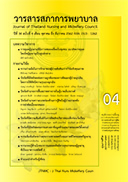การดูแลผู้สูงอายุที่มีภาวะสมองเสื่อมในชุมชน: แนวคิดการดูแล โดยยึดผู้สูงอายุเป็นศูนย์กลาง
คำสำคัญ:
การดูแลที่ยึดบุคคลเป็นศูนย์กลาง, ผู้สูงอายุที่มีภาวะสมองเสื่อมในชุมชนบทคัดย่อ
ผู้สูงอายุที่มีภาวะสมองเสื่อมเป็นผู้ที่มีภาวะพึ่งพิงและต้องการการดูแลระยะยาว ส่วนใหญ่อาศัยอยู่ในครอบครัวและชุมชน หน้าที่ในการดูแลจึงเป็นสมาชิกในครอบครัว การวางแผนจัดการและการเตรียมผู้ดูแลจึงเป็นเรื่องที่สำคัญ โดยผู้ดูแลต้องมีความรู้ ความเข้าใจ และทักษะในการดูแลที่ยืดหยุ่น การดูแลที่ยึดผู้สูงอายุเป็นศูนย์กลางในการดูแล เป็นวิธีการดูแลผู้สูงอายุโรคเรื้อรังที่มีภาวะพึ่งพิงที่บ้านที่มีคุณภาพ และเป็นแนวทางสำคัญในการพัฒนาคุณภาพการดูแลผู้สูงอายุที่มีภาวะสมองเสื่อม พยาบาลมีบทบาทสำคัญในการดูแลผู้สูงอายุที่มีภาวะสมองเสื่อมในชุมชน โดยการเสริมสร้างศักยภาพของผู้ดูแลและครอบครัวเพื่อให้การดูแลมีคุณภาพมากขึ้น บทความวิชาการนี้มุ่งอธิบาย แนวคิด ความหมาย ความสำคัญ องค์ประกอบผลของการดูแลโดยยึดผู้สูงอายุที่มีภาวะสมองเสื่อมเป็นศูนย์กลาง ปัญหาและอุปสรรคการนำแนวคิดการดูแลที่ยึดบุคคลเป็นศูนย์กลางไปใช้ในการดูแลผู้สูงอายุที่มีภาวะสมองเสื่อมและบทบาทของพยาบาลในการนำแนวคิดการดูแลโดยยึดผู้สูงอายุที่มีภาวะสมองเสื่อมเป็น
ศูนย์กลางสู่การปฏิบัติการดูแลผู้สูงอายุที่มีภาวะสมองเสื่อมในชุมชน
Downloads
References
14(3):367-429.
2. World Health Organization (WHO). Global action plan on the public health response to dementia 2017-
2025. Geneva: World Health Organization; 2017. Licence: CC By-NC-SA 3.0 IGO. [cited 2019 June 18].
Available from: URL:https://apps.who.int/iris/bitstream/handle/10665/259615/9789241513487-eng.pdf;jsessionid=1464D2203FDF2059DB750D7A754253FF?sequence=1
3. Pramote Prasartkul (Editor). Situation of the Thai elderly 2017. Bangkok: Deuan Tula Printing House; 2018. (in Thai).
4. Kunkantrakorn K. Dementia and Alzheimer disease. Thammasart Medical Journal 2018; 18(3): 442-468.
5. Muangpaisan W. Dementia: prevention, assessment and care. In Muangpaisan W, editor. Diagnosis of dementia. Bankok: Pappim Press; 2013. (in Thai).
6. Prince M, Wimo A, Guerchet M, Ali G, Wu Y & Prina M. World Alzheimer Report 2015: The global impact of dementia: an analysis of prevalence, incidence, cost and trends. London: Alzheimer’s Diseases International; 2016.16
7. Bureau of Information. News for social. [Internet]. 2017. [cited 2019 June 13]. Available from: URL:
http://pr.moph.go.th/iprg/include/admin_hotnew/show_hotnew.php?idHot_new=86580)
8. Thai Alzheimer Association. Diagnosis of dementia.In: Tantirittisak T., editor. Clinical practice guidelines:
dementia. Bangkok: Tanapress; 2014. (in Thai)
9. Steele CD. Nurse to nurse: dementia care. USA:McGraw-Hill Co; 2010.
10. Sasat S. Gerontological nursing: common problems and caring guideline. 3rd ed. Bangkok: Chulalongkorn
University Publisher; 2011. (in Thai)
11. Chansirikarn S. Handbook of extending the brain age. Bangkok: Pimdee Publisher; 2009. (in Thai)
12. Offce of the Permanent Secretary, Department of Health, Ministry of Public Health Practice guildline of fnancial allocation for long term care services [internet]. 2561 [cited 2019 June 13]. Available from: URL: https://apps.hpc.go.th/dl/web/index.php?r=download%2Fview&id=178
13. Bureau of Health Promotion, Department of Health,Ministry of Public Health. The report on Thai elderly
health survey B.E. 2556. Bangkok: Watcharin P.P.;2013 (in Thai)
14. Nolan, M., Davie, S., & Brown, J. (2004). Beyond person-centered care: a new vision for Gerontological
nursing, J Clin Nurs, 13(3), 45-53.
15. McCormack, B (2010). Person-centred nursing: theory and practice. A John Wiley & Sons, Ltd.,
Publication.
16. Kogan C. A., Wilber K. & Mosqueda L. (2015). Person-centered care for older adults with chronic
conditions and functional impairment: a systematic literature review, JAGS, 64(1):e1-7. doi:10.1111/jgs.13873.
17. Rogers CR. On Becoming a person. Boston:Houghton Mifflin; 1961.
18. Kitwood T. The technical, the personal, and the framing of dementia. Soc Beh. 1988; 3:161-79.
19. Kitwood T. Dementia reconsidered: the person comes frst. Buckingham: Open University Press, 1997.
20. Brooker D. What is person-centered care in dementia. Rev Clin Gerontol 2004; 13: 215-22.
21. Dewing J. Personhood and dementia: revisiting Tom Kitwood’s ideas. Int J of Older People Nurs. 2008;3 (1): 3-13.
22. Steenbergen E, van der Steen R, Smith S, Bright C & Kaaijk M (2013) Perspectives of person-centred
care. Nurs Stand. 2013; 27(48), 35-41.
23. Perez-Merino R. Strategies for enhancing the delivery of person-centred care. Nurs Stand. 2014; 28 (39):37-41.
24. Morton I. Person-centered approaches to dementia
care. Bicester: Winslow; 1999.
25. Cook EM, Manthorpe J. Introduction: Personalising psychosocial interventions to individual needs and
context. In: Cook EM, Manthorpe J, editors. Early psychosocial interventions in dementia. London and Philadelphia: Jessica Kingsley Pub; 2009. p. 11–36.
26. Edvardsson D, Winblad B, & Sandman PO. Person-centred care of people with severe Alzheimer’s disease: current status and ways forward. The Lancet Neurol. 2008; 7:362-7.
27. Cobban N. Improving domiciliary care for people with dementia and their carers: The raising the
standard project. In: Innes A, Archibald C, Murphy C,editors. Dementia and Social Inclusion: Marginalised Groups and Marginalised Areas of Dementia Research, Care and Practice. London: Jessica Kingsley Publishers; 2004.
28. Brooker D. Person-centred dementia care: Making sevices better. London: Jessica Kingsley Pub; 2007.
29. Love K & Pinkowitz J. Person-centered care for people with dementia: a theoretical and conceptual
framework. Generations. 2013; 37(3): 23-9
30. Brooker D. Woolley R. Lee D. Enriching opportunities for people living with dementia in nursing homes:
An evaluation of a multi-level activity-based model of care. Aging Mental Health. 2007; 11(4): 361-70.
31. Edvardsson D Fetherstonhaugh D & Nay R. Promoting a continuation of self and normality: person-centered
care as described by people with dementia, their family members and aged care staff. J Clin Nurses. 2010;
19 (17-18): 2611-18.
32. Brooker D. Dementia care mapping: a review of the research literature. Gerontologist. 2005; 45(1):11-18.
33. Cohen-Mansfeld J, Thein K, Marx MS, Dakheel-Ali M & Freedman L. Effcacy of non-pharmacologic intervention for agitation in advanced dementia: a randomized, placebo-controlled trial. J Clin Psychiatry. 2012; 73(9):1255-61.
34. Alzheimer’s Australia. Guiding person-centered dementia care in the community. [internet]. 2017 [cited
2019 June 10]. Avialble from URL: https://valuingpeople.org.au/sites/default/fles/ValuingPeople%20 Section%201_7.pdf;
35. World Health Organization (WHO). Towards a dementia plan: a WHO guide. Geneva; 2018. Licence: CC BYNC-SA 3.0 IGO. [cited 2019 June 12]. Available from: URL: https://www.who.int/mental_health/
neurology/dementia/policy_guidance/en/
36. Alzheimer’s Disease International, Alzheimer’s Australia. Dementia in the Asia Pacifc Region. London:
Alzheimer’s Disease International; 2014.
37. Sloane PD, Hoeffer B, Mitchell CM, McKenzie DA, Barrick AL & Rader J. Effect of person-centered
showering and the towel bath on bathing associated aggression, agitation, and discomfort in nursing home
residents with dementia: A randomized, controlled trial. J Am Geriatr Soc. 2004; 52: 1795–804.
38. Brownie S & Nan carrow S. Effects of person-centered care on residents and staff in aged-care facilities: a
systematic review. Clin Interv Aging. 2013; 8:1–10. https://doi.org/10.2147/CIA.S38589 PMID: 23319855
39. Fossey J, Ballard C, Juszczak E, James I, Alder N & Jacoby R. Effect of enhanced psychosocial care on
antipsychotic use in nursing home residents with severe dementia: cluster randomised trial. BMJ. 2006; 332:756–61.
40. Kim SY & Park M. Effectiveness of person-centered care on people with dementia: a systematic review and meta-analysis. Clin Interv Aging. 2017 17(12), 381-97.
41. Chenoweth L, Stein-Parbury J, Lapkin S, Wang A, Liu Z, & Williams A. Effects of person-centered care
at the organizational-level for people with dementia. A systematic review PLoS One. 2019; 22; 14(2):e0212686.
42. Edvardsson D. Notes on person-centred care: What it is and what it is not. Nordic J Nurs Res. 2015; 35, 65-66.
43. Lintern T, Woods B & Phair L. Before and after training: a case study of intervention. J of Dement Care. 2000;
8(1), 15-7.
44. Hill H. (2004). Talking the talk but not walking the walk: barriers to person centered care in dementia
[dissertation]. Melbourne (Vic): La Trobe Univ.; 2004.18
45. Moore L, Britten N, Lydahl D, Naldemirci O, Elam M,& Wolf A. Barriers and facilitators to the implementation
of person-centered care in different healthcare contexts.Scand J Caring Sci. 2017; 31: 662–673. https://
doi.org/10.1111/scs.12376 PMID: 27859459.
46. Berry L. The National Dementia Strategy: transforming care. Nurs Older People. 2009; 21(1): 3. PMID:
19248432
47. Kitwood T. Dementia reconsidered: the person comes frst. Buckingham: Open University Press; 2007.
48. Doyle PJ, Rubinstein RL. Person-centered dementia care and the cultural matrix of othering. Gerontologist. 2013; 54(6): 952–63.
49. Eriksen S, Helvik A-S, Juvet LK, Skovdahl K, Forsund LH & Grov EK. The experience of relations
in persons with dementia: a systematic meta-synthesis. Dement Geriatr Cogn Disord. 2016; 42: 342–68.
50. Strategy and Planning Division, Ministry of Public Health. (2558). Strategies, indicators and guidling
for data collection, fscal year B.E. 2559. Bangkok: Ministry of Public Health. (in Thai)
51. Chianwichai K. Role of nurse care manager in long term care for older persons in community. [Master
thesis] Bangkok: Chulalongkorn University.; 2017.(in Thai)







